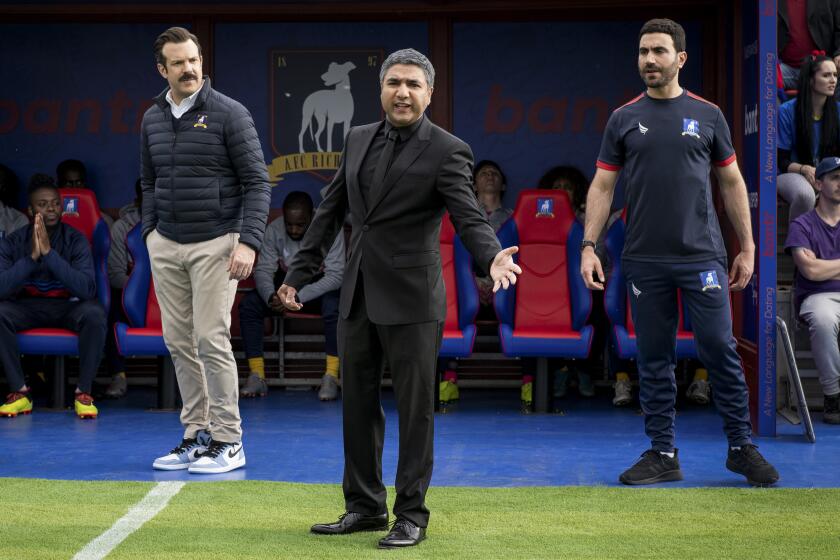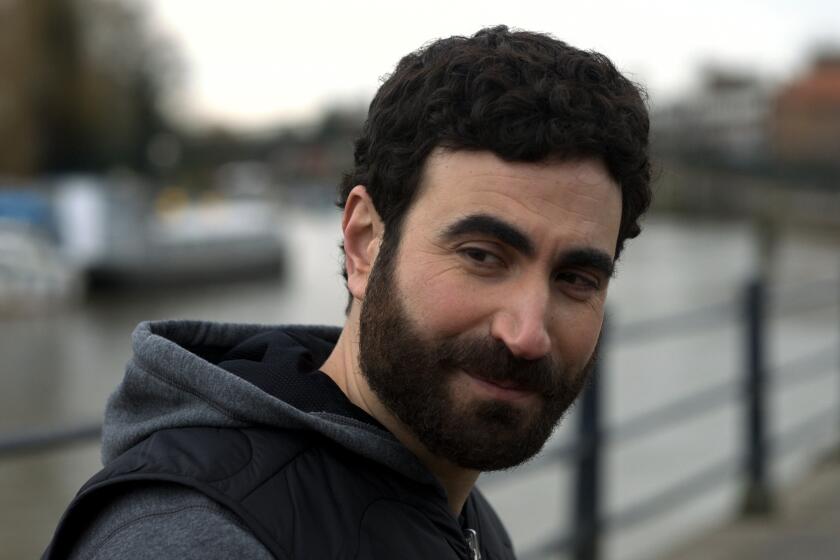In Season 2, ‘Ted Lasso’ became part of a grand tradition: art worth fighting over
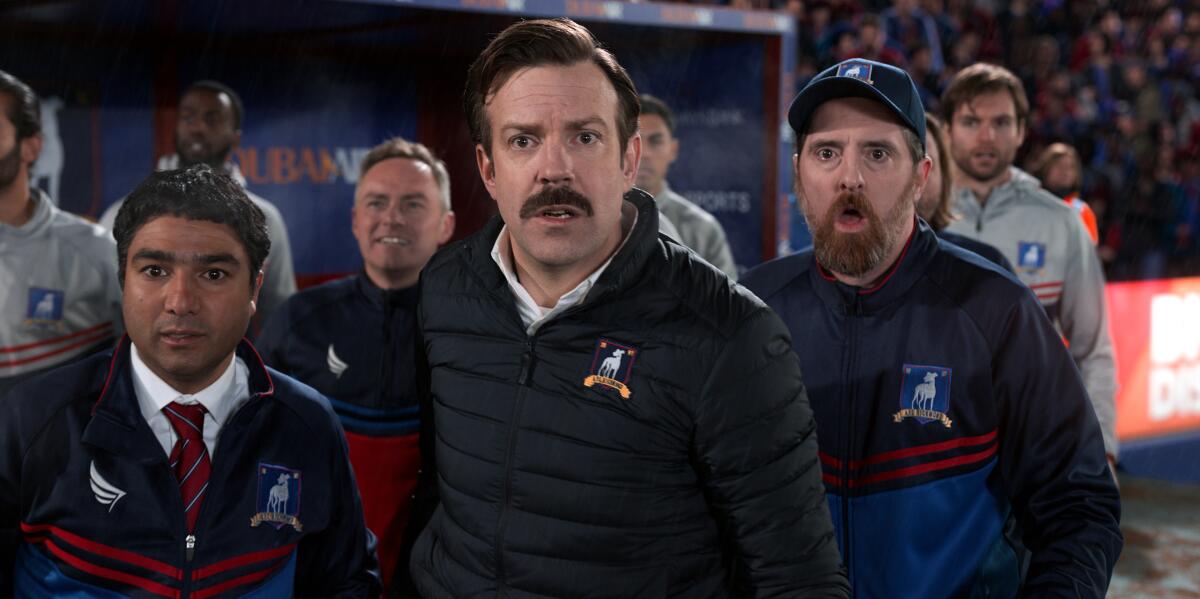
- Share via
As the second season of “Ted Lasso” got underway in July — it came to its conclusion Friday — there was some discussion, among our TV team and in the wider world, about whether it was living up to the first, was too nice, too free of conflict, had used up its good ideas and lost its way.
Those conversations about what a TV show should or shouldn’t do, or was or wasn’t giving its audience, got me thinking about the degree to which creators are responsible to the consumers of their creations, and the question of who “owns” a work of popular art.
As a critic, there is always the temptation to second-guess a work, which is not quite the same as coming to terms with what works and what doesn’t and its relationship to the world. The latter offers a theory, the former a remedy. I try not to write prescriptions. I don’t care whether a show has had a troubled genesis, whether an actor or showrunner has been replaced, or if a project has spent years bouncing from network to network before a check was cut and a director finally got to call “Action!” Ultimately I’m interested only in the work before me, not the uncountable other versions that may exist in the multiverse, where different paths have been taken and choices made. Were the Beatles right to swap Pete Best for Ringo? The fans who protested with shouts of “Pete Is Best” and “Pete forever, Ringo never” didn’t think so. Happily these are the Beatles we have. Stanley Kubrick burned the outtakes from his films to make sure his cut really was final.
Even Mohammed struggled with the jaw-dropping conclusion of his character’s arc: ‘I can’t believe that you’re gonna test your audience like this.’
Your single-LP edit of the Beatles’ “The White Album” — like Steven Soderbergh’s self-described “morally and legally suspect” “Butcher’s Cut” of Michael Cimino’s very long “Heaven’s Gate” — is only an academic exercise, a parlor game. Even the official stripped-down re-release of the Phil Spector-ized “Let It Be” does not replace the album the Beatles issued in 1970; that chapter is written, just as Peter Jackson’s coming long cut of the long-out-of-circulation documentary “Let It Be” will not erase the original.
Who owns a work? There’s legal ownership of the work or the intellectual property; there’s the person or persons who actually made the work; there’s the sense in which an actor might define a part and make it theirs, the way that, say, Harrison Ford owns Indiana Jones; and there’s a fan’s sense of ownership, which is not without power: “We made you. You are nothing without us.” In some respects, it might be the most powerful of all.
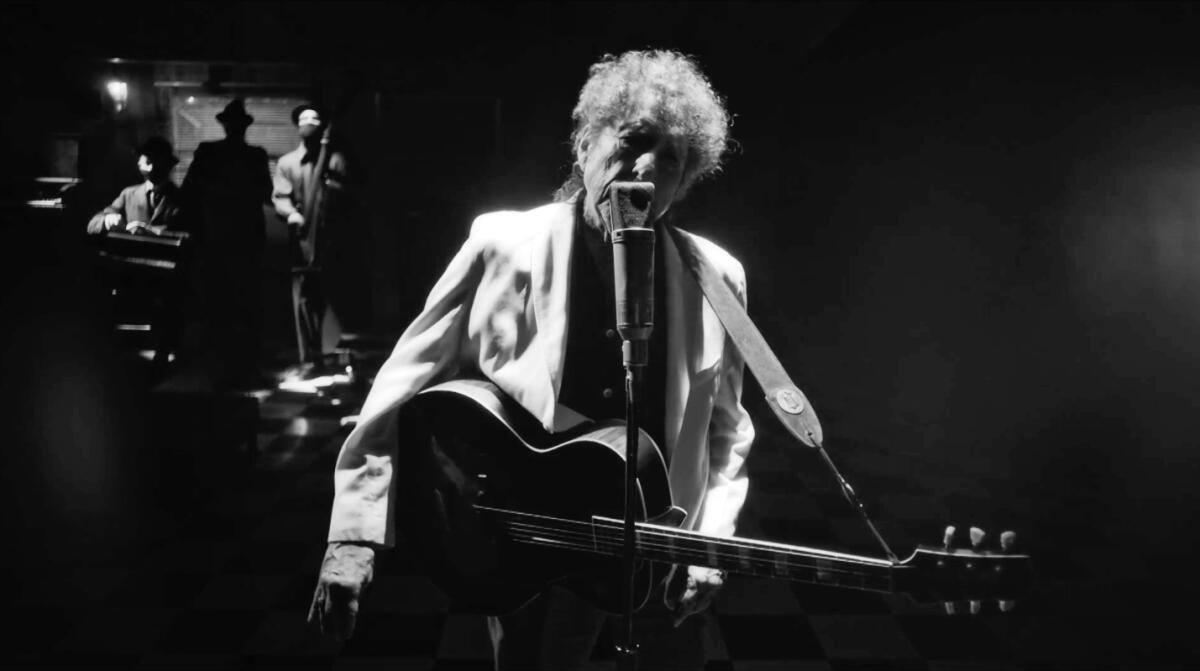
Disney has long been a voracious acquirer of IP — including the Muppets, Marvel and “Star Wars” — which they have exploited in what often strikes me as terrible ways, though to be sure culture has a lot to do with the order one experiences it. Undoubtedly there are those who prefer the Disney Pooh or Alice or Mary Poppins to that of Milne or Carroll or Travers, viewers who would find Jean Cocteau’s film of “Beauty and the Beast” wholly inferior to the wholly inferior Disney version. Recent exchanges of Hollywood money will produce a “Charlie and the Chocolate Factory” prequel, from Warner Bros. and the Roald Dahl Story Co., and a host of original stories, from Amazon, set in the “Lord of the Rings” universe. And you’ll be getting another Indiana Jones movie, whatever that’ll do to your childhood memories “The Crystal Skull” hasn’t already done.
As to the fans, anything effective enough to have fans has disgruntled fans — the more effective, the greater the potential for disgruntlement.
Like Bob Dylan at Newport, Miles Davis confounded old fans by going electric, and then confounded the new fans by going funk, and then confounded them again by recording ballads by Cyndi Lauper and Michael Jackson. Dylan’s entire career has been one of disappointing a portion of his audience with every new album and voice. There is an easy argument to be made that he hasn’t always been a good curator of his own work, given credence by “The Bootleg Series,” which collects outtakes, alternate takes and orphans, previously hidden under a bushel basket in a basement. Still, this has not made him a whit less Bob Dylan; it might even be what makes him Bob Dylan.
In its second season, Apple’s Emmy nominee has gone from merely soft to downright syrupy. Now, it needs its sharpest-edged character more than ever.
As fans, we can feel protective of characters we love as if they were not an invention of writers and actors, as if their feelings could be hurt by what they are made to do. I have often experienced something of the sort watching a show that is creating drama for drama’s sake, not as an organic outgrowth of its characters or premise, but to keep viewers interested over a 10- or 22-episode season. I know I’m not the only viewer worried that the Roy and Keeley relationship is being set up for third-season “Ted Lasso” trouble, especially when the second season did such an excellent job of portraying its strength.
There’s a dark side to such protectiveness; you see it especially in science-fiction and adventure franchises, many of which have their origins in less diverse times, and whose fans can sometimes be irrationally proprietary. “Doctor Who,” whose roots go back nearly 60 years, has featured 13 different actors in essentially the same part, the time- and space-traveling Doctor — all of them white British males (three Scottish, the rest English) before Jodie Whittaker became the first woman in the role in 2017. And though this seemed not only completely reasonable, given the transformational nature of the character, but long overdue, there were the expected complaints of ruined childhood memories and performative wokeness.

Some fans do claim ownership in a more positive, proactive way. Fan fiction, which has been around in something like its current fashion for more than 50 years — “Star Trek” stories were circulating in mimeographed fanzines while the show was still on the air — puts homemade, ultra-non-canonical spins on TV shows, books, movies, games and plays , shared in whatever manner the latest technology allows. Not everyone who has had a thought about Kirk and Spock in a romantic relationship will sit down and write a story about it; not all who feels the need for more “Game of Thrones” will make their own movie to get it. But people do, and I find it easy to applaud the impulse, whatever it produces.
On the website fanfiction.net, hundreds of different shows have been embroidered upon, not just the obvious ones, like “Star Trek,” “Supernatural,” “The X-Files” and “Xena: Warrior Princess,” but less expected series like “The Queen’s Gambit” and “Schitt’s Creek” and the quite unlikely “Green Acres,” “Matlock” and “Aquabats! Super Show!” And, yes, “Ted Lasso”: In the story “Fried Green Tomatoes,” by user seirina, “Ted introduces Rebecca to a U.S. culinary delight”; in “We’re Not in Kansas Anymore,” by GirlDoingHerBest, “Ted Lasso has a 21-year-old niece, Alex, who comes to visit her favorite uncle in hopes he can help her deal with the struggles of early adulthood.”
I said that I don’t pay attention to the dramas of production when writing criticism. But I do try to remember, at least, that it is not easy making television, or anything at all, even when you factor out all the executive trolls whose bridges must be crossed on the way to getting something onscreen — the commitments that sometimes must be honored even after it’s clear they shouldn’t have been made in the first place, the sets you’ve built you can’t not use, the inventions mothered by necessity, the mistakes too expensive to rectify. Anyone who has ever made anything, from a pie to a movie to a movie review, knows that a solution is not always obvious in the moment, even when it’s the obvious solution. And no one sets out to make bad art (unless it’s good bad art, like some John Waters films), or bad pies.
The 50-minute ‘Shadow Kingdom’ is part concert, part art film, with Dylan in great voice and the music possibly prerecorded.
Works unappreciated in their time have gone on to be considered classics, while things celebrated as eternally great have been nearly forgotten, or are remembered only as kitsch. (History is a dustbin, culture a trash heap.) But less beloved later works don’t negate the worth of prized earlier ones — middling late paintings by Andy Warhol never hurt his prices — just as the diminished reputation of a work does not diminish the impact it had on its own times. The late actor Tommy Kirk survived his film career by decades and made some terrible movies after Disney canceled his contract. (He was gay; it didn’t fit the brand.) But he will be remembered with love by those who remember his best work and gain fans as long as Disney keeps “The Shaggy Dog” in circulation.
Inspiration comes in waves; careers have peaks and valleys. Cole Porter was considered washed up when, at 57, he wrote “Kiss Me, Kate!” Actors who have been called “box office poison” at some point in their career include Fred Astaire, Jimmy Cagney, Katharine Hepburn, Nicolas Cage and Ben Affleck. Athletes, whole teams, have slumps, and no one can say why. Creation is mysterious even to its creators, or else every play would run forever, no television show would ever be canceled and all songs would tie for number one on the pop chart, and stay there. The greatest artists produce ordinary, even inferior, stuff between the masterpieces — things they might have labored on the hardest of all.
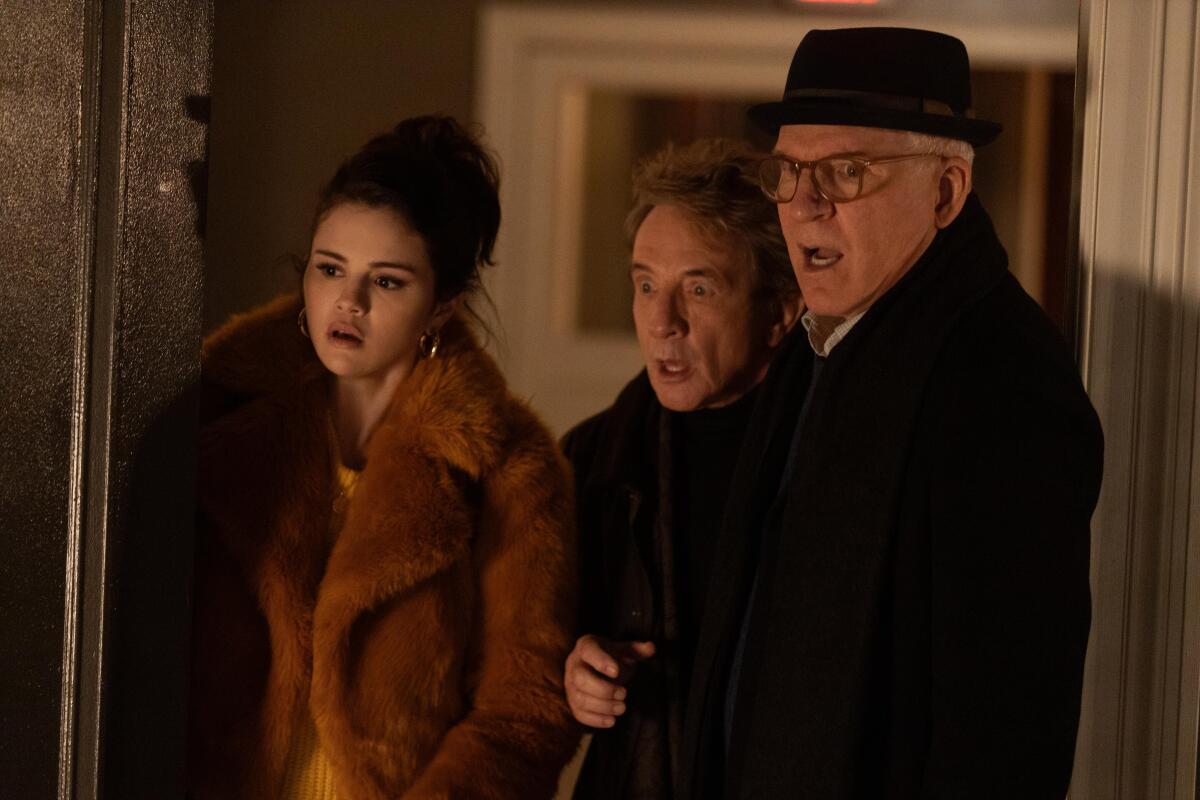
Raised on biographies and biopics, we’ve developed the habit of reducing complex lives and careers to dramas: We love the story of the person who goes out on top. Perhaps because it gives me some kind of hope for a productive old(ish) age, I find it gratifying that Steve Martin and Martin Short are in a series, “Only Murders in the Building,” — a show, interestingly enough, about fanship gone wild — that has been well-received, inter-generationally, and renewed for a second season. But the notion of “safeguarding a legacy” is an awful one. It supposes that artists owe something to posterity — to the world that survives them — and ought to simply close up shop when their work becomes less agile or bankable, rather than sully their professional reputation with inferior product.
It is true that some things — TV shows, pop groups — survive into a period of diminishing returns. Often this it is the product not of a creative impulse but a business decision: How much more money can be milked out of all this thing? I have my own list of shows that ran out of gas before they slowly rolled into their destination, and most of those were extremely popular until the end. But who’s to say what’s too long? Who’s art is it anyway? You might decide to bring your sitcom to an end while the ratings are high, as Carl Reiner did “The Dick Van Dyke Show” or Jerry Seinfeld and Larry David did “Seinfeld.” Or you might not. Given the opportunity to continue, why not, if that’s what you want to do? You might not find an audience, but that is most things.
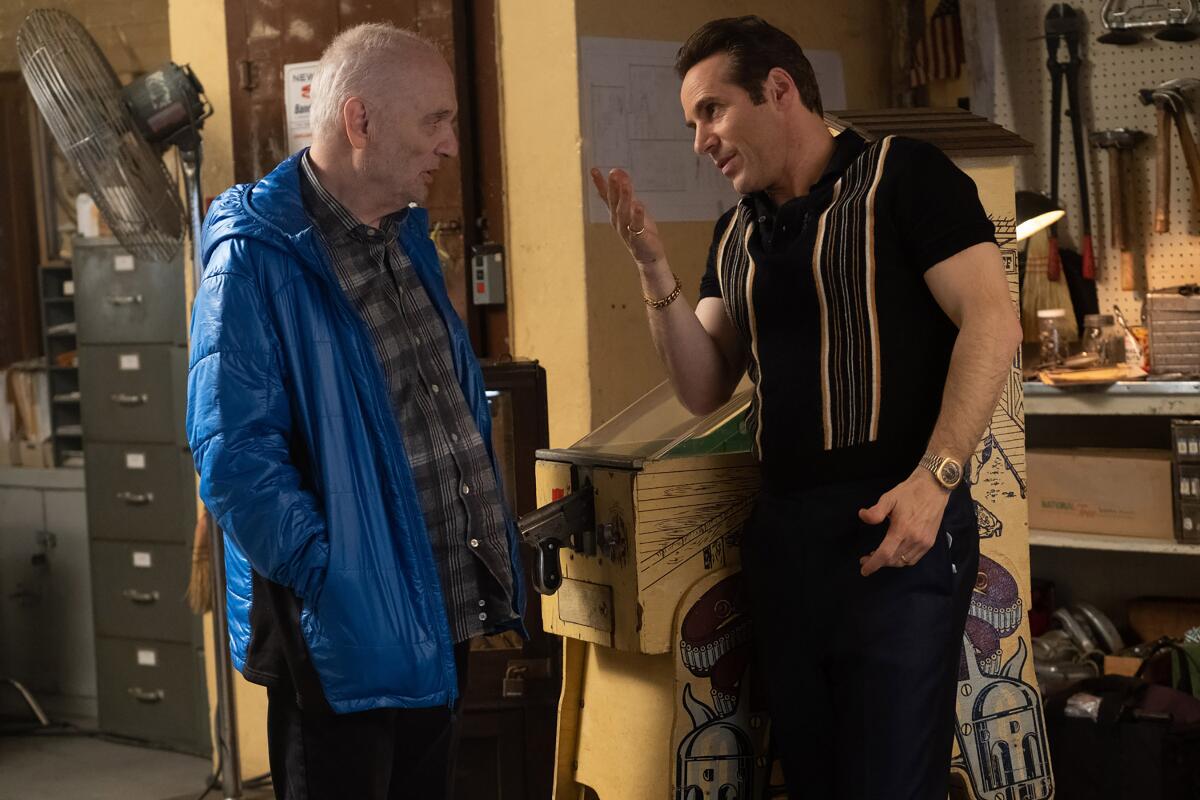
Besides, the retreat of youthful powers may make room for new and equally valuable qualities. Frank Sinatra became a more profound singer of ballads as he became a less sure singer of the galloping barn-burners his audience still cheered loudest for. Mississippi John Hurt made less of an impression at 35, when he made his first (unsuccessful) recordings, than at 70, when he was rediscovered by the folk revival, playing with spider-web delicacy. Infirmities may suggest productive new strategies for making art. Energy can obscure expression. Patina is earned with age. Something imperfect can also be beautiful.
Should David Chase not have made “The Many Saints of Newark,” a feature prequel to “The Sopranos” that no one seems to have liked? Ask David Chase. I don’t think there’s any “should” about it. And remember: Fonzie did manage to jump the shark, and “Happy Days” ran for another six seasons. “Jump the shark” might as well mean, “You should be so lucky to have a show that runs 11 years, with two hit spinoffs.”
Whatever its latest season seemed to deliver or withhold episode by episode, we can see now that “Ted Lasso” was quite purposeful in developing its themes and plot lines, and that the new season was very much a fulfillment of the first. As Nick Mohammed, who plays Nate, recently told The Times, co-creator/star Jason Sudeikis had let him know where the character was headed even before the second season was ordered, demonstrating a Ted Lasso-like optimism about the future of his own show. In any case, it’s their story to tell.
More to Read
The complete guide to home viewing
Get Screen Gab for everything about the TV shows and streaming movies everyone’s talking about.
You may occasionally receive promotional content from the Los Angeles Times.
